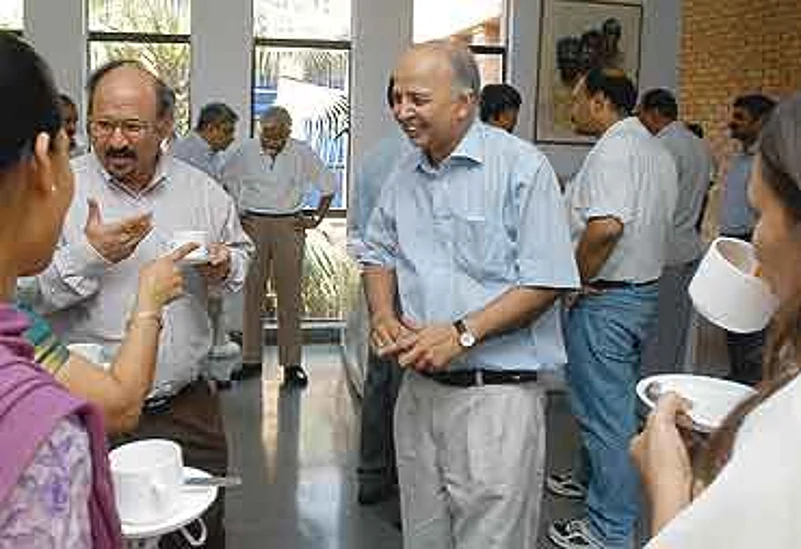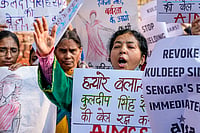But is that a good way of judging performances? Don’t B-schools have a larger role to play than merely ensuring lucrative jobs for their students? Aren’t they responsible for creating new knowledge and practices that can be gainfully adopted by the industry? Shouldn’t they innovate in pedagogy to make knowledge more user-friendly and effective, and upgrade curriculum consistently to meet the shifting corporate needs? In effect, shouldn’t they be creating world-class managers?
The Outlook-Cfore survey takes a holistic view while ranking the country’s top B-schools. Our methodology gives more weight to the ability of an institute to add value, rather than merely perpetuate the brand myth. So, those that don’t perform consistently, or stagnate, lose out. It’s not surprising, therefore, to find that a few schools, which rest on past laurels, chose not to participate in our survey. But there are others, especially some of the self-financed ones, which have shown a will to cultivate a climate of innovations and constantly improve their processes. These are what we call the new learning B-schools.
The priority of any B-school is to provide future leaders. But to achieve that objective, the schools need to have an internal leader—the CEO or the director—who can assimilate new ideas, technology and practices. More importantly, one who can as easily abandon those which are not yielding results. A self-financed B-school typically has an effective director who charts out a clear growth strategy and makes sure that the faculty members internalise it and work as a team.
At MDI, Gurgaon, for instance, the same HR practices that are taught to students are used to promote teamwork among faculty members. Every morning, the teachers meet over a cup of tea for 15 minutes to sort out the day-to-day coordination issues. These discussions also help in building stronger relationships between them. The faculty council meets every month to monitor implementation, and makes mid-course adjustments, if required. New ideas are debated and discussed, and achievements of faculty members are celebrated. The long-term strategic issues and vision are discussed in the annual retreats of the faculty.

Obviously, such schools take steps to attract the best teaching talents. IMT and IMI (Delhi) pay salaries that are over 35 per cent more than what’s prescribed by AICTE for IIMs and IITs. The workload is restricted to four or five courses in a year, so that the teachers get ample time for other things like research. XIM Bhubaneshwar pays faculty members a perk of Rs 45,000 per extra course (over and above the minimum of four a year). There are other incentives too—a payment of Rs 65,000 if a paper is published in an international journal and Rs 1 lakh for authoring a book; a maximum of Rs 1,50,000 per teacher for attending international conferences and seminars every alternate year; 60 per cent of the revenues that’s earned from training and consulting projects undertaken by a teacher.
Having a good faculty is not enough.These B-schools strive to woo the best students.This becomes important since the self-financed schools are infamous for ‘management quotas’ where money and nepotism can guarantee admission.To ensure quality intake under the management-quota category, several institutes have established strict entry barriers.IMT didn’t admit anyone below a score of 96 percentile (CAT).Narsee Monjee admitted only those who were shortlisted in the admission test.

Of course, another sign of a progressive B-school is the curriculum which has to be reviewed and updated regularly based on industry inputs. The Amrita School of Business, Coimbatore, introduced 16 new electives last year. Meditation and yoga have become part of curriculum in schools like PSG and Amrita. As far as pedagogy is concerned, case method, live projects, game- playing, role-playing and computer simulation are used as effective means to impart knowledge and skills.
A continuous evaluation process that consists of quizzes, assignments, presentations and tests at regular intervals has replaced end-term exams. Student evaluations are conducted twice a term, so that mid-term corrections can be made. At MDI, outbound activity is being used as a serious pedagogical tool to stimulate and develop competencies. Theatre is being used as a medium to enhance them. imi has introduced the concept of team-teaching in select courses where multi-disciplinary focus is necessary—like in the course on ‘Infrastructure Project Finance’.

To assist students in making the correct choices, some schools have strong mentoring programmes. In Amity B-School, Delhi, each student is assigned an industry mentor, an alumnus mentor and a faculty mentor to provide sound counselling on their academic, career and personal concerns. The infrastructure in these B-schools is upgraded regularly. Every student is equipped with a laptop, and the campuses are networked with optical fibre backbone and wireless (WiFi) broadband internet connectivity. In institutes like XIMB and MDI, each classroom is equipped with a LAN system by which the faculty is able to access library resources and his/her personal notes through the file-sharing system and get it to the classroom without moving a single piece of paper.
The next step is to seek out effective industry interface. Hyderabad’s ICFAi has a faculty-supervised summer internship programme, an integral component of the curriculum with credits equivalent to five normal courses. Students undertake 14-week live projects in industry and are evaluated by the faculty and the industry guide. TAPMI, Manipal, has newly started Management In Practice, where real-life managerial issues are identified and analysed by the students. XIMB has introduced courses in which senior industry personnel conduct classes for a few days.

To expose students to international practices, Welingkar, Mumbai, has introduced global internship to countries like Ghana, Romania, Kenya, Germany and Japan. Today, almost 5 per cent of B-schools have international exchange programmes. Last year, MDI sent 91 students and 19 faculty members abroad. Similarly, 18 faculty and 90 students came from abroad to spend a term at mdi. Foreign languages are also being taught in some B-schools so that the students can think and act globally. Coimbatore’s PSG has signed a contract with the cultural unit of the French embassy and a Japanese firm to teach their languages to its students as part of their course.
Interaction with business and other thought leaders is a regular feature.At Amity, three or four CEOs from diverse industry sectors are invited every week to interact with students on specific topics.CEOs are also invited to dine with a small group of students in an informal setting.SP Jain, Mumbai, has the CEO Leadership Series where students interact with a business leader. NMIMS, Mumbai, also has initiated a company-adoption programme where each faculty member adopts 4-5 firms, interacts with them, and conducts joint research.XIMB has gone a step further. It encourages students to help rural entrepreneurs. In poor districts like Kalahandi, XIMB students have assisted self-help groups to produce jams and pickles which are marketed in cities.
Strong industry interface helps an institute to reduce its dependence on fees.Many B-schools earn sizable revenues from training programmes for corporate executives. MDI earned over Rs 7 crore from the management development programmes last year. Such revenue models provide a solution to a B-school’s resource constraint—a limiting factor that hampers investments in infrastructure and intellectual capital.
More importantly, B-schools are incorporating processes and systems that have become the norm in various industries. The Alliance Business School, Bangalore, has embarked on an ambitious plan to implement PCMM (People Capability Maturity Model), a framework that’s primarily used in the software industry. It claims it has reached Level 4 of the PCMM and will soon reach Level 5. Under this, all processes—from admissions to career mapping to interfacing with stakeholders—have been identified, and key metrics have been developed and implemented.

In the end, it becomes a virtuous cycle. For example, the admissions process uses a unique Decision Support System (DSS) to mine from a historical knowledge base to project the potential of a prospective candidate. Similarly, students are encouraged to map a career, choose a sector they would like to be in, and in many cases, the company they would like to work for. Appropriate skills are imparted to significantly increase the probability of the student getting a job in the target company.
Clearly, several B-schools are emerging out of the hitherto overbearing shadow of the IIMs. Many of them are thinking ahead and planning for the future. They are the ones who are learning as they go along the path of innovative thinking. In the process, they’re constantly inching ahead in the Outlook—Cfore rankings. Perhaps, in the future, the new learning B-schools will force the already established and world-recognised IIMs to rethink their processes and systems.
(The author is director, Cfore)


























